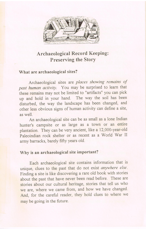 This booklet instructs amateur artifact hunters how to preserve
This booklet instructs amateur artifact hunters how to preserveand protect archaeological sites.
Archaeological Record Keeping:
Preserving the Story
What are archaeological sites?
Archaeological sites are places showing remains of past human activity. You may be surprised to learn that these remains may not be limited to ‘artifacts” you can pick up and hold in your hand. The way the soil has been disturbed, the way the landscape has been changed, and other less obvious signs of human activity can define a site,as well.
An archaeological site can be as small as a lone Indian hunter’s campsite or as large as a town or an entire plantation. They can be very ancient, like a 12,000-year-old Paleoindian rock shelter or as recent as a World War II army barracks, barely fifty years old.
Why is an archaeological site important?
Each archaeological site contains information that is unique, clues to the past that do not exist anywhere else. Finding a site is like discovering a rare old book with stories about the past that have never been read before. These are stories about our cultural heritage, stories that tell us who we are, where we came from, and how we have changed. And, for the careful reader, they hold clues to where we may be going in the future.
. . .